英语时态之一般过去时
(完整)小学英语语法时态一般过去时详解
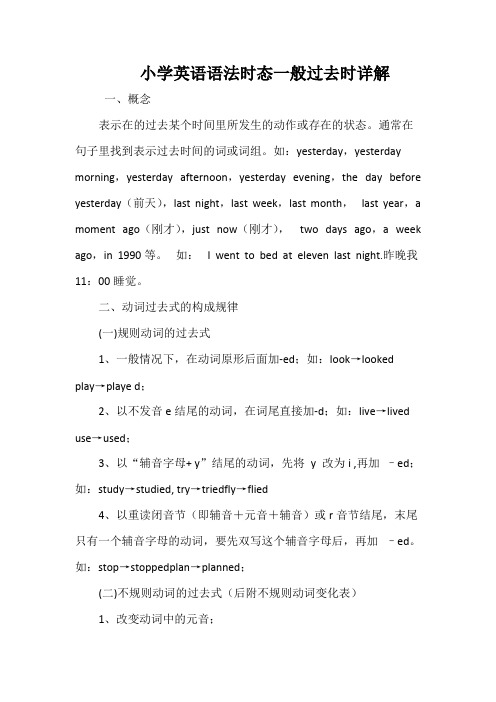
小学英语语法时态一般过去时详解一、概念表示在的过去某个时间里所发生的动作或存在的状态。
通常在句子里找到表示过去时间的词或词组。
如:yesterday,yesterday morning,yesterday afternoon,yesterday evening,the day before yesterday(前天),last night,last week,last month,last year,a moment ago(刚才),just now(刚才),two days ago,a week ago,in 1990等。
如:I went to bed at eleven last night.昨晚我11:00睡觉。
二、动词过去式的构成规律(一)规则动词的过去式1、一般情况下,在动词原形后面加-ed;如:look→looked play→playe d;2、以不发音e结尾的动词,在词尾直接加-d;如:live→lived use→used;3、以“辅音字母+ y”结尾的动词,先将y 改为i ,再加–ed;如:study→studied, try→triedfly→flied4、以重读闭音节(即辅音+元音+辅音)或r音节结尾,末尾只有一个辅音字母的动词,要先双写这个辅音字母后,再加–ed。
如:stop→stoppedplan→planned;(二)不规则动词的过去式(后附不规则动词变化表)1、改变动词中的元音;begin→began drink→drank come→came eat→ate grow→grew run→ran know→knew win→wonspeak→spoketake→took write→wrote get→got2、变词尾的–d 为–t ;build→built lend→lent send→sent spend→spent bend→bent3、与动词原形一样;cut→cut put→put cost→cost hurt→hurt shut→shut4、变-ay 为-aid (少数动词);say→said pay→paid lay→laid5、采用不同词根;sell→sold teach→taught buy→bought6、其他。
高中英语十六种时态用法详解之一般过去时

play — played,offer — offered,weigh —
的那段记忆以后,捧腹大笑:“你怎么这么搞笑哦,这么花痴哦。”只有
weighed,destroy
—
destroyed,sign
—
signed.(2)在以字母 e 结尾的动词后,只加-d。 如:like—liked,provide—provided,hate— hated,date—dated。(3)在以“辅音字母+y”结 尾的动词后,则改 y 为 i,再加—ed。如: supply — supplied,fly — flied,study — studied.(4) 在以单短元音的重读闭音节结尾且,末尾只有一
。
常
与
过
去
时
间
yesterday,thismorning,justnow,amomentago, inMay,lastnight/year/week,onceuponatime,t heotherday,before „ ,when clause,inthepast 连 用 。 如 – :
Whatdidyoudoyesterday? 昨 天 你 干 了 什 么 ? ImetLinTaothismorning.今天上午我会到了林 涛。Iwasthereamomentago.刚才我在那儿。2.一
—
时,后接不定式的完成时;或它们的过去完成时
Hale Waihona Puke 接不定式的一般式,都可表示过去未曾实现的意 图 、 打 算 或 希 望 。 如 :
Ihopedtohavebeeninvitedtohisweddingparty.
的那段记忆以后 — I hadhopedtobeinvitedtohisweddingceremony. 我本希望他来邀请我参加他的婚礼。
小学英语时态之 一般过去时讲解课件ppt

一般过去时:
定义: 一般过去时,是表示过去某一时刻或某一段时间内发生的动作或存在
的状态。
标志词: yesterday, just now, …ago, last…, this morning …
结构: 谓语是be动词
谓语是行为动词
肯定句: 主语+ was/were + 其他 否定句: 主语+ was/were + not + 其他 一般疑问句: Was/Were + 主语+其他? 肯定句: 主语+ 动词的过去式 + 其他 否定句: 主语+ didn’t +动词原形 + 其他 一般疑问句:Did + 主语+ 动词原形 +其他?
at the weekends this morning often
usually
last Mid-Autumn Festival
every day three days ago on Mondays
tomorrow a moment ago 14 years ago
找出表示一般过去时的时间副词。
( B) 1. My mother had breakfast and____to work.
A. go B. went C. going D. to go
( A)2. -- How __ your vacation?
-- It was pretty good. A. was B. were C. did D. do
( )3.Each student one picture.
A.draw B. draws C. drawing D.to drawing
初中英语语法 八大时态之一般过去时课件

I study in Beijing. I studied in Beijing .
she stops. she stopped.
I go to school by bike every day. I went to school by bike yesterday.
以e结尾的,直接在词尾加d dance - danced 辅音加y结尾,变y为i加ed study - studied 重读闭音节结尾,双写词尾字母加 ed stop - stopped 3.不规则变化: 没有变化 cut -cut put-put come-come hit-hit let-let 特殊情况 have/has—had, go---went, eat---ate, say—said
1
last year
时间
last week
标志 2 last weekend
The day before
3 。。。。。。
一般过去时
动词的变化
一般过去时-含有be动词的
• She is in Beijing.
She was in Beijing .
• I am a student.
I was a student.
read — read
write — wrote say — said
play — played
learn — learned buy — bought cry — cried
study — studied swim — swam walk — walked
一般过去时主要动词的变化:
英语一般过去时语法知识点

英语一般过去时语法知识点英语一般过去时(Simple Past Tense)是表示过去某个时间发生或存在的动作或状态的一种时态。
以下是英语一般过去时的语法知识点:1. 句子结构:主语+ 动词过去式+ 其他成分。
2. 动词过去式的构成:- 一般情况下,直接在动词原形后面加-ed。
例如:play →played,watch →watched,want →wanted。
- 以不发音的字母“e”结尾的动词,在加-ed前先去掉“e”。
例如:live →lived,change →changed。
- 以辅音字母+y结尾的动词,将y变为i再加-ed。
例如:study →studied,carry →carried。
- 一些不规则动词的过去式需要记忆,例如:go →went,eat →ate,see →saw,do →did。
3. 动词过去式的否定和疑问形式:- 否定形式:主语+ did not + 动词原形+ 其他成分。
缩写为didn't。
例如:I didn't play tennis yesterday.- 疑问形式:Did + 主语+ 动词原形+ 其他成分例如:Did you watch the movie last night?4. 一般过去时的时间状语:昨天(yesterday)、上个月(last month)、去年(last year)等表示过去某个具体时间的时间状语。
5. 一般过去时的用法:- 表示过去某个具体时间发生的动作或状态。
例如:I went to the beach yesterday.- 表示过去一段时间内发生的动作或状态。
例如:I lived in London for two years.- 表示过去习惯性的动作或状态。
例如:When I was a child, I always played with my friends.以上就是英语一般过去时的语法知识点。
记得多加练习,熟练掌握一般过去时的用法。
英语时态:一般过去时
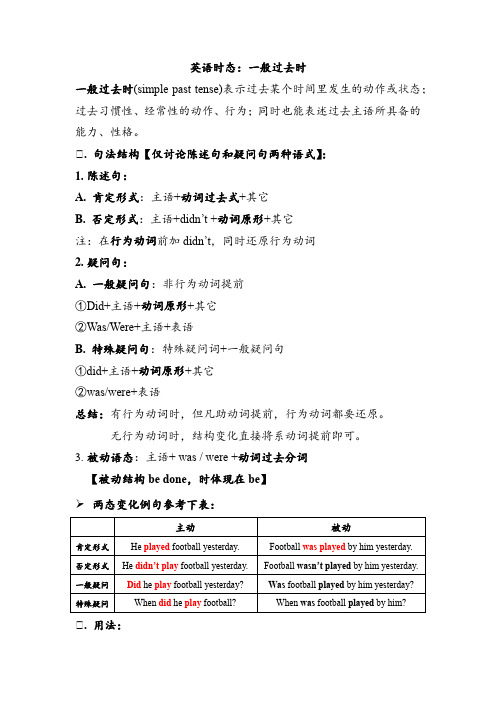
英语时态:一般过去时一般过去时(simple past tense)表示过去某个时间里发生的动作或状态;过去习惯性、经常性的动作、行为;同时也能表述过去主语所具备的能力、性格。
Ⅰ. 句法结构【仅讨论陈述句和疑问句两种语式】:1.陈述句:A. 肯定形式:主语+动词过去式+其它B. 否定形式:主语+didn’t +动词原形+其它注:在行为动词前加didn’t,同时还原行为动词2.疑问句:A. 一般疑问句:非行为动词提前①Did+主语+动词原形+其它②Was/Were+主语+表语B. 特殊疑问句:特殊疑问词+一般疑问句①did+主语+动词原形+其它②was/were+表语总结:有行为动词时,但凡助动词提前,行为动词都要还原。
无行为动词时,结构变化直接将系动词提前即可。
3.被动语态:主语+ was / were +动词过去分词【被动结构be done,时体现在be】➢两态变化例句参考下表:Ⅰ. 用法:1.一般过去时表示在过去某个特定时间发生,也可以表示过去习惯性、经常性的动作。
(一般不强调动作的影响,只说明的事情。
)I talked with Catherine yesterday morning.His mother cooked him breakfast.2.一般过去时常与表示过去的时间状语或从句连用,如:yesterday, last week, in the past, in 1993, at that time, once, during the war, before, a few days ago, when 等。
3.表示过去连续发生的动作时,要用过去时。
这种情况下,往往没有表示过去的时间状语,而通过上下文来表示。
The boy cried for a while,and then drank a cup of tea.4.表示在此之前一段时间内经常或反复的动作。
常与always,never 等连用。
英语时态复习之一般过去时
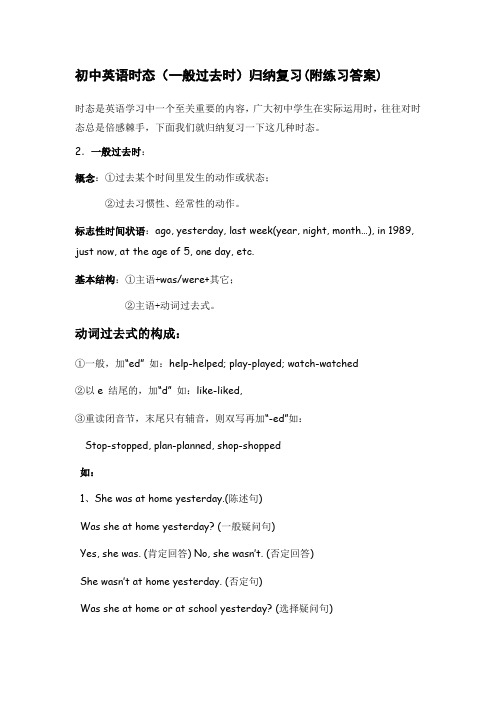
初中英语时态(一般过去时)归纳复习(附练习答案)时态是英语学习中一个至关重要的内容,广大初中学生在实际运用时,往往对时态总是倍感棘手,下面我们就归纳复习一下这几种时态。
2.一般过去时:概念:①过去某个时间里发生的动作或状态;②过去习惯性、经常性的动作。
标志性时间状语:ago, yesterday, last week(year, night, month…), in 1989, just now, at the age of 5, one day, etc.基本结构:①主语+was/were+其它;②主语+动词过去式。
动词过去式的构成:①一般,加“ed”如:help-helped; play-played; watch-watched②以e 结尾的,加“d” 如:like-liked,③重读闭音节,末尾只有辅音,则双写再加“-ed”如:Stop-stopped, plan-planned, shop-shopped如:1、She was at home yesterday.(陈述句)Was she at home yesterday? (一般疑问句)Yes, she was. (肯定回答) No, she wasn’t. (否定回答)She wasn’t at home yesterday. (否定句)Was she at home or at school yesterday? (选择疑问句)She was at home yesterday, wasn’t she? (反意疑问句) Where was she yesterday? (特殊疑问句)2、He went to Shanghai two days ago. (陈述句)He didn't go to Shanghai two days ago. (否定句)Did he go to Shanghai two days ago? (一般疑问句)Yes, he did. (肯定回答) No, he didn't. (否定回答)Did he go to Shanghai or Shenzhen two days ago? (选择疑问句) He went to Shanghai two days ago, didn't he? (反意疑问句) When did he go to Shanghai? (特殊疑问句)Where did he go two days ago? (特殊疑问句)露一小手一般过去时练习一、请用正确动词形式填空。
一般过去时
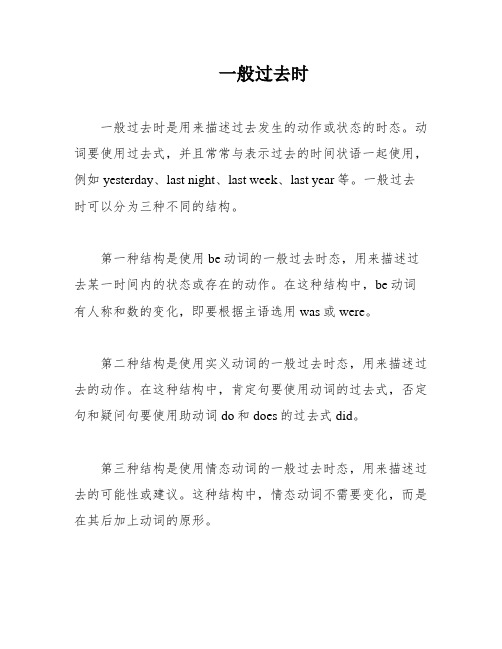
一般过去时一般过去时是用来描述过去发生的动作或状态的时态。
动词要使用过去式,并且常常与表示过去的时间状语一起使用,例如yesterday、last night、last week、last year等。
一般过去时可以分为三种不同的结构。
第一种结构是使用be动词的一般过去时态,用来描述过去某一时间内的状态或存在的动作。
在这种结构中,be动词有人称和数的变化,即要根据主语选用was或were。
第二种结构是使用实义动词的一般过去时态,用来描述过去的动作。
在这种结构中,肯定句要使用动词的过去式,否定句和疑问句要使用助动词do和does的过去式did。
第三种结构是使用情态动词的一般过去时态,用来描述过去的可能性或建议。
这种结构中,情态动词不需要变化,而是在其后加上动词的原形。
需要注意的是,在构成一般过去时的助动词did和didn't后面要跟动词的原形,而且do和does的过去时均为did。
因此,在使用一般过去时时,需要注意动词的形式和助动词的使用。
例如,原句“XXX.”可以改写为“XXX.”,否定句为“I didn’t do XXX.”,一般疑问句为“Did you do your homework yesterday?”,回答可以是“Yes。
I did.”或“No。
I didn’t.”。
1.情态动词的过去式为can→could。
may→might。
must→had to。
will→would。
should→should have。
2.特殊疑问句的构成形式有三种:a。
特殊疑问词+be过去式+主语+其他?b。
特殊疑问词+情态助动词过去式+主语+动词原形+其他?c。
特殊疑问词+do/does过去式+主语+动词原形+其他?例如:What was your former name?(你以前叫什么名字?)Why was he late for school last Monday?(上星期一他为什么迟到?)What could she do twenty years ago?(20年前她能做什么?)3.一般过去时的判断标志词包括:yesterday,the day before yesterday,last + 时间,this morning + 时间 + ago,just now,a moment ago,in + 过去的时间。
小学英语语法时态一般过去时详解
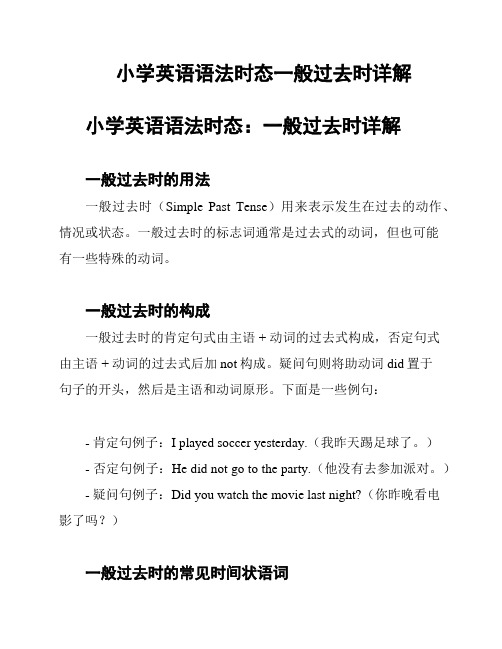
小学英语语法时态一般过去时详解小学英语语法时态:一般过去时详解一般过去时的用法一般过去时(Simple Past Tense)用来表示发生在过去的动作、情况或状态。
一般过去时的标志词通常是过去式的动词,但也可能有一些特殊的动词。
一般过去时的构成一般过去时的肯定句式由主语 + 动词的过去式构成,否定句式由主语 + 动词的过去式后加not构成。
疑问句则将助动词did置于句子的开头,然后是主语和动词原形。
下面是一些例句:- 肯定句例子:I played soccer yesterday.(我昨天踢足球了。
)- 否定句例子:He did not go to the party.(他没有去参加派对。
)- 疑问句例子:Did you watch the movie last night?(你昨晚看电影了吗?)一般过去时的常见时间状语词一般过去时通常会和一些时间状语词一起使用,以明确动作发生的具体时间。
以下是一些常见的时间状语词:- yesterday(昨天)- last week(上周)- two days ago(两天前)- in 1998(在1998年)一般过去时的特殊用法一般过去时有一些特殊的用法需要注意:1. 表示过去经常性的动作或惯。
例如:When I was young, I played soccer every day.(当我年轻时,我每天都踢足球。
)2. 表示过去事实或真理。
例如:The earth revolved around the sun.(地球绕太阳转。
)总结一般过去时用来描述发生在过去的动作、情况或状态。
它的构成简单,使用过去式的动词作为标志词。
通过加入时间状语词,可以更明确地指出动作发生的具体时间。
同时,一般过去时还有一些特殊的用法,需要灵活运用。
>注意:本文内容仅供参考,具体使用时请根据实际情况和教材要求进行调整。
英语时态:一般过去时

英语时态:一般过去时一、定义一般过去时可表示过去某个时间里发生的动作、事情或存在的状态;也可表示过去习惯性、经常性的动作、行为;或表示过去主语所具备的能力、性格。
一般过去时动作发生的时间是“过去”,动作的状态是“一般”。
(注:“一般”态表示的是“动作经常发生或频繁发生”。
)二、时间状语一般过去时常和表示过去某一时间的状语连用,主要包括:yesterday,yesterday morning/afternoon/evening昨天,昨天早上/下午/晚上last night/week/month/year昨晚/上周/上个月/去年the night/week/month/year before last前天夜里/上上个星期/上上个月/前年two minutes/hours/days/weeks/months/years ago两分钟/小时/天/周/月/年前one morning/afternoon/evening在某一早上/下午/晚上that morning/afternoon/evening/day/week/month/summer/year那个早上/那个下午/那个晚上/那天/那周/那个月/那个夏天/那一年just now,at that time,in1990...刚才,当时/在那时,在1990年...三、动词形式一般过去时的动词需用过去式。
动词过去式的构成规则主要包括以下几种:(1)规则动词,在动词原形后直接加ed。
发音规则:在以浊辅音或元音结尾的词后发音/d/,以清辅音结尾的词后发音/t/,以t 或d结尾的词后发音/id/。
示例:ask-asked/t/climb-climbed/d/open-opened/d/pass-passed/t/want-wanted/id/need-needed/id/(2)动词以不发音的e结尾,则只在词尾加d。
发音规则:在以浊辅音或元音结尾的词后发音/d/,以清辅音结尾的词后发音/t/,以t 或d结尾的词后发音/id/。
一般过去时定义,结构,标志词,用法

一般过去时定义,结构,标志词,用法一般过去时是英语中最基本的过去时态之一,它用于描述过去发生的动作或状态。
本文将介绍一般过去时的定义、结构、标志词和用法。
一、定义一般过去时是指发生在过去的动作或状态,不考虑其持续时间或是否已经完成。
它用于描述已经结束的事情,通常与表示过去的时间短语一起使用。
二、结构一般过去时的结构很简单,主要由动词的过去式构成。
对于大多数动词,过去式是在动词原形后加上-ed,如walked,talked,played 等。
但是,有一些动词的过去式是不规则的,需要记忆,如go的过去式是went,eat的过去式是ate等。
另外,一般过去时的肯定句结构为:主语 + 动词过去式 + 其他。
如:I walked to the park yesterday.(我昨天走到了公园。
)否定句的结构为:主语 + did not + 动词原形 + 其他。
如:I did not walk to the park yesterday.(我昨天没有走到公园。
)疑问句的结构为:Did + 主语 + 动词原形 + 其他?如:Did you walk to the park yesterday?(你昨天走到了公园吗?)三、标志词一般过去时的标志词有很多,其中最常见的有以下几种:1. 表示过去的时间短语,如yesterday(昨天)、last week(上个星期)、in 1999(在1999年)等。
2. 过去式的动词,如walked(走)、talked(谈话)、played(玩)等。
3. 过去式的助动词did,如did not(没做)、did you(你做了吗?)等。
四、用法一般过去时通常用于以下情况:1. 描述过去的事件或状态,如:I went to the park yesterday.(我昨天去了公园。
)2. 描述过去的习惯或经常性动作,如:When I was a child, I played with dolls every day.(我小时候每天都和玩偶玩。
高中英语语法一般过去时详细讲解
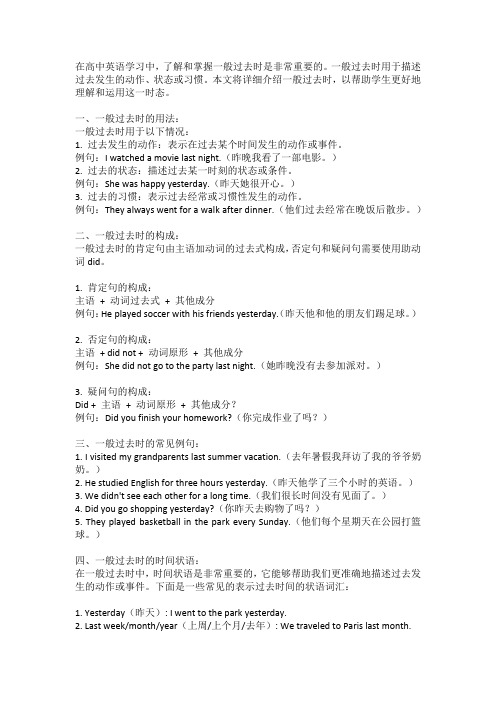
在高中英语学习中,了解和掌握一般过去时是非常重要的。
一般过去时用于描述过去发生的动作、状态或习惯。
本文将详细介绍一般过去时,以帮助学生更好地理解和运用这一时态。
一、一般过去时的用法:一般过去时用于以下情况:1. 过去发生的动作:表示在过去某个时间发生的动作或事件。
例句:I watched a movie last night.(昨晚我看了一部电影。
)2. 过去的状态:描述过去某一时刻的状态或条件。
例句:She was happy yesterday.(昨天她很开心。
)3. 过去的习惯:表示过去经常或习惯性发生的动作。
例句:They always went for a walk after dinner.(他们过去经常在晚饭后散步。
)二、一般过去时的构成:一般过去时的肯定句由主语加动词的过去式构成,否定句和疑问句需要使用助动词did。
1. 肯定句的构成:主语+ 动词过去式+ 其他成分例句:He played soccer with his friends yesterday.(昨天他和他的朋友们踢足球。
)2. 否定句的构成:主语+ did not + 动词原形+ 其他成分例句:She did not go to the party last night.(她昨晚没有去参加派对。
)3. 疑问句的构成:Did + 主语+ 动词原形+ 其他成分?例句:Did you finish your homework?(你完成作业了吗?)三、一般过去时的常见例句:1. I visited my grandparents last summer vacation.(去年暑假我拜访了我的爷爷奶奶。
)2. He studied English for three hours yesterday.(昨天他学了三个小时的英语。
)3. We didn't see each other for a long time.(我们很长时间没有见面了。
时态—一般过去时(英语语法课件)
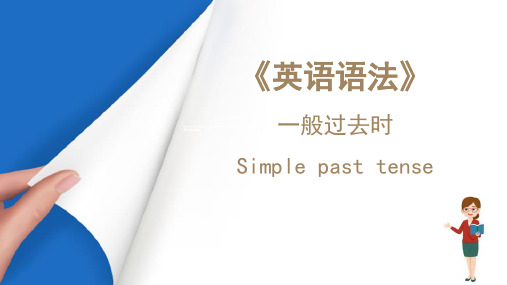
灵活运用
Dear Sir,
Our weekend at your hotel was bad. Our room was big but everything was very old. Our friend Robin cleaned our room and fixed a broken chair. My mother wanted to read a book but the lamp was too small.My dad got some hamburgers from the hotel kitchen, but they were cold and tasted bad. I wanted to watch TV but the TV didn't work. The people in Room 301 listened to loud music. I didn't sleep all night. I'm sorry, but we didn't enjoy our stay very much.
要点呈现
am-was run-ran
go-went study-studied play-played
Simple past tense-- to describe the things happened in the past; to describe the things we usually do in the past.
表示过去的词及表达 1. yesterday, ago, the day before yesterday 2.一段时间+ ago an hour ago, ten minutes ago st +时间词 last week, last year, last month 4.一个过去的时间 when he was five years old,just now 5.特殊词汇 on用在特定句型中表示现在时间和将来时间, 表示婉转语气或设想。 eg. 1. I wondered if you could give me some help. 2. It’s time you had a holiday.
初中英语时态之一(一般过去时总结)

一般过去时(simple past tense)表示过去某个时间里发生的非持续性动作或存在的状态,用动词的过去式表示,常和表示过去的时间状语连用,如:yesterday,last night,in 1990,two days ago,before,the age of等。
一般过去时也表示过去经常或反复发生的动作,常和often,always等表示频率的时间状语连用。
表示过去习惯性、经常性的动作、行为;过去主语所具备的能力和性格。
一般过去时不需考虑第三人称单数(简称三单)的变化。
句法结构肯定形式主语+动词过去式+其他例句:She often came to help us in those days.否定形式一般疑问句①Did+主语+谓语动词原型+其他?②②Was\Were+主语+表语?例句:Did I do homework?需要注意Be 动词、情态动词、实意动词的变化1.Be 动词的一般过去时态.在没有实义动词的句子中使用be动词,am is 的过去式为was; are的过去式为were.构成:肯定句:主语+was (were) +表语如:I was late yesterday. (昨天我迟到了。
)否定句:主语+was (were) +not+表语如:We weren't late yesterday. (我们昨天没有迟到)【注意】:当句中含有系动词was,were时,可直接在其后加not构成否定句。
如:I was on the Interntwhen you called me.当你打电话给我时,我在上网。
→ :I was not/wasn't on the Internt when you called me .当你打电话给我时,我不在上网。
疑问句:Was (Were) +主语+表语当谓语动词提前并直接或间接表达注意时态特殊疑问句:特殊疑问词+was (were) +主语+表语2.实义动词的一般过去时态肯定句要使用动词的过去式,否定句和疑问句要使用助动词do和does 的过去式did.否定句:主语+didn't +动词原形+宾语疑问句:Did +主语+动词原形+宾语3.助动词和情态动词过去式如下:shall―should(将要)用于第一人称单数will―would(将要)用于所有人称can—could(能,会)may―might(可以)must―must (必须)have to―had to(不得不)助动词和情态动词的过去时态要使用他们的过去式,后面的动词还使用原形。
小学英语语法详解时态-----一般过去时
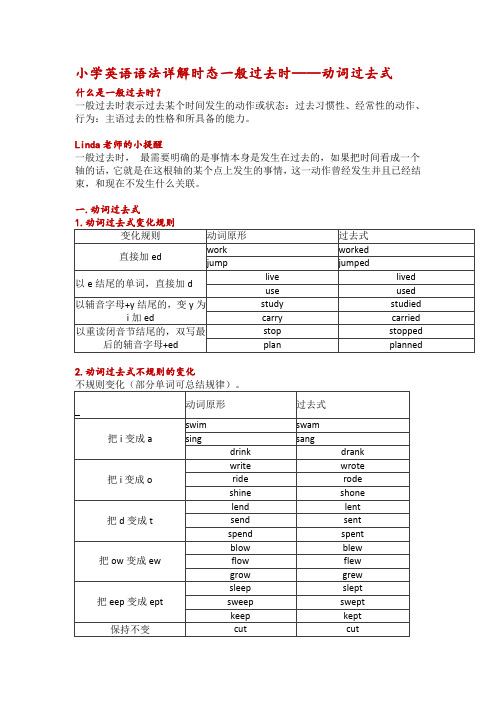
小学英语语法详解时态一般过去时——动词过去式什么是一般过去时?一般过去时表示过去某个时间发生的动作或状态:过去习惯性、经常性的动作、行为:主语过去的性格和所具备的能力。
Linda老师的小提醒一般过去时,最需要明确的是事情本身是发生在过去的,如果把时间看成一个轴的话,它就是在这根轴的某个点上发生的事情,这一动作曾经发生并且已经结束,和现在不发生什么关联。
一.动词过去式2.动词过去式不规则的变化Linda老师的小提醒★大部分过去式还是需要去记忆的:be动词的过去式一was(am,is的过去式). were(are的过去式)。
一些实义动词的过去式,dig→ dug,run→ ran,eat→ ate,fall→ fell,lie→ lay等。
★部分动词的过去式两种都是可以的,比如:lean→ leaned/leant;dream→ dreamt/dreamed;bet→ bet/betted等。
小学英语语法详解时态一般过去时——一般过去时的句式变化二.一般过去时的句式变化1.陈述句:主语+动词过去式+其他I saw the rianbow yesterday.我昨天看到了彩虹。
They went to he park last Sunday.上周日他们去了公园。
Ben got up at six this morning.本今天早上是六点起床的。
2.一般疑问句1)将be动词提到句首陈述句:It was an egg yesterday.它昨天还是一个蛋。
一般疑问句:Was it an egg yesterday?它昨天还是一个蛋吗?陈述句:They were at school just now.他们刚才还在学校。
一般疑问句:Were they at school just now?他们刚才还在学校吗?Linda老师的小提醒主语是第一人称和第二人称的句子,其过去时变化时,要注意be动词的变化。
一般疑问句:Were you at home last night?你昨天晚上在家吗?肯定回答:Yes,I was.否定回答:No,I wasn't.2)用助动词did陈述句:I did my homework at school,我在学校做了作业。
英语四种时态总结
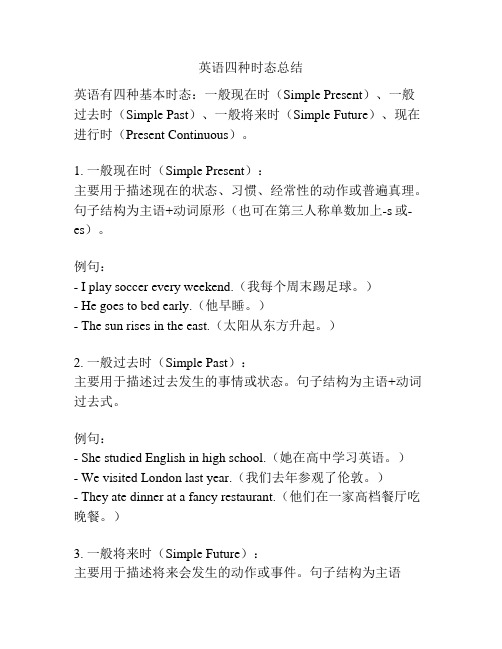
英语四种时态总结英语有四种基本时态:一般现在时(Simple Present)、一般过去时(Simple Past)、一般将来时(Simple Future)、现在进行时(Present Continuous)。
1. 一般现在时(Simple Present):主要用于描述现在的状态、习惯、经常性的动作或普遍真理。
句子结构为主语+动词原形(也可在第三人称单数加上-s或-es)。
例句:- I play soccer every weekend.(我每个周末踢足球。
)- He goes to bed early.(他早睡。
)- The sun rises in the east.(太阳从东方升起。
)2. 一般过去时(Simple Past):主要用于描述过去发生的事情或状态。
句子结构为主语+动词过去式。
例句:- She studied English in high school.(她在高中学习英语。
)- We visited London last year.(我们去年参观了伦敦。
)- They ate dinner at a fancy restaurant.(他们在一家高档餐厅吃晚餐。
)3. 一般将来时(Simple Future):主要用于描述将来会发生的动作或事件。
句子结构为主语+will+动词原形。
例句:- I will go to the gym tomorrow.(我明天会去健身房。
)- She will take the exam next week.(她下周会参加考试。
)- We will have a party on Friday.(我们星期五会举办一场派对。
)4. 现在进行时(Present Continuous):主要用于描述当前正在进行的动作。
句子结构为主语+be动词(am/is/are)+动词的ing形式。
例句:- They are watching a movie now.(他们正在看电影。
一般过去时讲解

一般过去时讲解
一般过去时的常见错误
时态不一致:在描述过去的事情时,容易将一些动作的时态与一般过去时不一致,导 致意思表达不清或产生歧义 动词形式错误:在使用一般过去时的时候,容易将动词的形式拼写错误或使用不当, 导致句子意思错误或语法错误
写作练习:通过写作练习来巩固一般过去时的运用。可以写日记、故事、短文等,记 录过去发生的事情,用一般过去时描述动作和状态。在写作过程中,注意时态的准确 性和语法的规范性
一般过去时讲解
口语练习
在口语练习中,尝试使用一般过去 时来描述过去的事情,表达对过去 的看法和回忆。可以通过模拟对话、 角色扮演等方式进行练习,提高对
pmห้องสมุดไป่ตู้ 我们原本打算下午3点在
火车站见面
03
表示过去的虚拟语气
在表示与现实相反的情况时, 可以使用一般过去时,表示虚 拟语气。例如:If I had known the answer, I would have told you. 如果我知道 答案的话,早就告诉你了。 (实际上不知道答案)
04
表示对过去的推测
在表示对过去的推测时,可以 使用一般过去时。例如:It must have rained last night, because the ground is wet. 昨晚一定下雨了,因 为地面是湿的
一般过去时讲解
一般过去时的其他注意事项
注意动词时态的一致性:在使用一般过去时的时候,要注意句子中其他动词的时态与 之一致。例如,在描述过去发生的事情时,所有的动作都应使用过去时态,除非有特 殊需要使用其他时态 注意动词的形式:在一般过去时中,动词需要使用其过去式形式。不同形式的动词过 去式有不同的拼写和发音,需要注意正确使用 注意时间状语的搭配:在使用一般过去时的时候,要与适当的时间状语进行搭配。例 如,"yesterday"应与一般过去时搭配使用,"tomorrow"应与一般将来时搭配使用
一般过去时
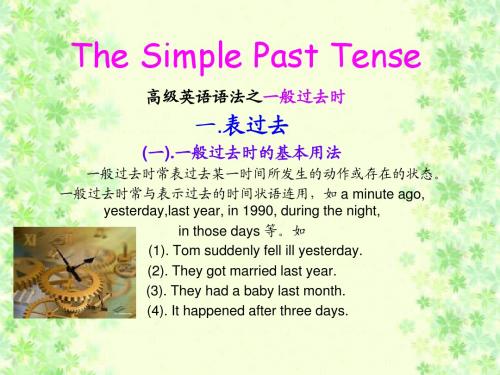
(二).一般过去时用于since 从句
主句的谓语动词如用现在完成时,其后接的since引导的从句一般 须用一般过去时。如: (1).You haven’t changed much since we last met. (2).It’s been over a year since I came back from the countryside. 如果since从句的谓语动词是无限动词或静态动词的一般过去时, 则一般仍表动作或状态的结束,并无持续性,如: (3).It’s been a long time since I lived here.我不住这里已经好久了。 (4).It has been ten years since I was a teacher.我不当老师已有 十年了。
The Simple Past Tense
高级英语语法之一般过去时
一.表过去
(一).一般过去时的基本用法
一般过去时常表过去某一时间所发生的动作或存在的状态。 一般过去时常与表示过去的时间状语连用,如 a minute ago, yesterday,last year, in 1990, during the night, in those days 等。如 (1). Tom suddenly fell ill yesterday. (2). They got married last year. (3). They had a baby last month. (4). It happened after three days.
无限动词变为有限动词时,其一般过去时表已完成的动作。而一 般情况下,无限动词仍表持续的动作,如: (6). I sat in the chair and my cat sat on the rug. (7). They ate in the school’s dining room…He looked at her untouched plate. “ You’re not eating.” he said. 当然,一般过去时表重复动作时,也不会完成,如: (8). In those days she went to see her father in the hospital ever day .
- 1、下载文档前请自行甄别文档内容的完整性,平台不提供额外的编辑、内容补充、找答案等附加服务。
- 2、"仅部分预览"的文档,不可在线预览部分如存在完整性等问题,可反馈申请退款(可完整预览的文档不适用该条件!)。
- 3、如文档侵犯您的权益,请联系客服反馈,我们会尽快为您处理(人工客服工作时间:9:00-18:30)。
英语时态--- 一般过去时1.表过去发生的事情或存在的状态eg Suddenly,the clouds cleared and the rain stopped.2.表过去经常发生的事情eg I was very thin in my childhood.3.带有确定的过去的时间状语eg Did you meet yesterday? He left just now.基本结构:①be动词(was. were);②行为动词(过去时)1.直接加ed:work—— worked look——looked2.以不发音e结尾的单词,直接加d:live ——lived hope——hoped use——used3.以辅音字母+y结尾的,变y为i加ed:study—— studied carry——carried worry——worried4.以重读闭音节结尾的,双写最后的辅音字母+ed:stop—— stopped plan——planned5.不规则变化的动词过去式:have---had are---were get---got say---said feel---felt do/does---did is---was go---went drink--drank eat--ate bring----brought think----thoughtbuy----bought catch---- caught teach ---- taught sit----sat wear----worecut----cut sweep----swept sleep——slept become----became句法结构1、肯定形式主语+动词过去式+其他例句:She often came to help us in those days.2、否定形式①was/were+not;②在行为动词前加didn't,同时还原行为动词例句:I didn't know you like coffee.3、一般疑问句①Did+主语+谓语动词原型+其他?②Was\Were+主语+表语?例句:Did I do homework?习题:一、写出下列动词的过去式is\am_________ fly_______ plant________ are ________ drink_________ play_______ go________ make ________ does_________ dance________ worry________ ask _____ eat__________ draw________ do ________put______ pass_______ read_______二、用be动词的适当形式填空1. I ______ an English teacher now.2. She _______ happy yesterday.3. They _______ glad to see each other last month.4. Helen and Nancy ________ good friends.5. The little dog _____ two years old this year.6. Look, there ________ lots of grapes here.7. There ________ a sign on the chair on Monday.8. Today _____ the second of June. Yesterday ______ the first of June. It _____ Children's Day. All the students ______ very excited.三、句型变换1 There was a car in front of the house just now.否定句:__________________________________________________________ 一般疑问句:_________________________________________________________ 肯定回答:__________________________________________________________ 否定回答:__________________________________________________________2 They played football in the playground.否定句:__________________________________________________________ 一般疑问句:__________________________________________________________ 肯定回答:__________________________________________________________否定回答:__________________________________________________________四、用所给动词的适当形式填空1. I ______ (watch) a cartoon on Saturday.2. Her father _______ (read) a newspaper last night.3. We _________ to zoo yesterday, we _____ to the park. (go)4. ______ you _______ (visit) your relatives last Spring Festival?5. ______ he _______ (fly) a kite on Sunday? Yes, he ______.6. Gao Shan _______ (pull) up carrots last National Day holiday.7. I ____________ (sweep) the floor yesterday, but my mother ______.8. What _________ she _________ (find) in the garden last morning?She _________ (find) a beautiful butterfly.9. It _________ (be) Ben's birthday last Friday10. 10. We all _________ (have) a good time last night.11. He _________ (jump) high on last Sports Day.12. 12. Helen _________ (milk) a cow on Friday.13. She likes _________ newspapers, but she _________ a book yesterday. (read)14. He _______ football now, but they _______ basketball just now. (play)15. Jim's mother _________ (plant) trees just now.16. _______ they ________ (sweep) the floor on Sunday? No, they _________.17. I _______ (watch) a cartoon on Monday.18 We ____ (go) to school on Sunday.19. It ____ (be) the 2nd of November yesterday. Mr White ___ (go) to his office by car.20. Gao Shan ________ (put) the book on his head a moment ago.21. Don't ______ the house. Mum _______ it yesterday. (clean)22. What _________ you ______ just now? I _______ some housework. (do)23. They _________ (make) a kite a week ago.24. I want to ______ apples. But my dad _______ all of them last month. (pick)25. _______ he ______ the flowers this morning? Yes, he _____. (water)26. She ____ (be) a pretty girl. Look, she _____ (do) Chinese dances.27. The students often _________ (draw) some pictures in the art room.28.What ______ Mike do on the farm? He ________ cows. (milk)五、句型转换1、Lucy did her homework at home.(改否定句)Lucy ___________ ___________ her homework at home.2、He found some meat in the fridge(冰箱).(变一般疑问句)___________ he __________ ___________ meat in the fridge?3、She stayed there for a week.(对划线部分提问)__________ ___________ __________ she __________ there?4、There was some orange in the cup.(变一般疑问句)_________ there ___________ orange in the cup?。
